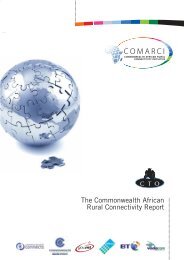Guide to measuring information and ... - unesdoc - Unesco
Guide to measuring information and ... - unesdoc - Unesco
Guide to measuring information and ... - unesdoc - Unesco
Create successful ePaper yourself
Turn your PDF publications into a flip-book with our unique Google optimized e-Paper software.
ED2 Proportion of schools with a television used for educational purposes (for ISCED levels 1-3)<br />
Definition:<br />
Number of schools which offer television-assisted<br />
instruction, expressed as a percentage of the <strong>to</strong>tal<br />
number of schools in the country, for ISCED levels 1-<br />
3.<br />
Data requirement:<br />
(EIT) Number of educational institutions (public <strong>and</strong><br />
private) with television-assisted instruction for ISCED<br />
levels 1-3.<br />
(refer <strong>to</strong> questionnaire item C.1.4)<br />
(EI) Number of educational institutions (public <strong>and</strong><br />
private) for ISCED levels 1-3.<br />
(refer <strong>to</strong> questionnaire item C.1)<br />
Formula:<br />
3<br />
<br />
h 1<br />
3<br />
<br />
h 1<br />
EIT<br />
EI<br />
t<br />
h<br />
t<br />
h<br />
* 100<br />
- 32 -<br />
Purpose:<br />
To measure the overall presence of televisionassisted<br />
instruction in schools.<br />
Method of collection:<br />
Administrative data collection through annual school<br />
census (or extract data from school records).<br />
Data source(s):<br />
Statistical unit of the Ministry of Education or,<br />
alternatively, the national statistical office.<br />
Where:<br />
EIT t<br />
h = Number of educational institutions with television-assisted instruction at level of<br />
education h in school-year t<br />
EI t<br />
h = Number of educational institutions at level of education h in school-year t<br />
Analysis <strong>and</strong> interpretation:<br />
A high percentage or value for this indica<strong>to</strong>r shows that<br />
television-based technologies are a widespread mode<br />
of instruction within schools in a given country, or vice<br />
versa. This reflects only the degree of availability or<br />
accessibility of this mode of delivery in schools, <strong>and</strong><br />
not the actual intensity of use.<br />
By comparing this indica<strong>to</strong>r <strong>to</strong> the proportion of schools<br />
providing other modes of education service delivery<br />
using ICT facilities, one can know the relative<br />
predominance <strong>and</strong> accessibility of different ICT used<br />
for teaching <strong>and</strong> learning purposes within the country<br />
or across countries.<br />
Besides its use for international comparison, this<br />
indica<strong>to</strong>r can also be calculated <strong>and</strong> analysed by<br />
ISCED levels, geographical regions, urban/rural areas,<br />
<strong>and</strong> public/private institutions <strong>to</strong> identify patterns <strong>and</strong><br />
potential discrepancies.<br />
Methodological <strong>and</strong> definition issues or<br />
operational limitations:<br />
A television set is considered a st<strong>and</strong>-alone device<br />
(in working condition) capable of receiving<br />
broadcast television signals using popular access<br />
means (such as over-the-air, cable <strong>and</strong> satellite).<br />
Television broadcast receivers integrated in<strong>to</strong> other<br />
devices (such as a computer, PDA, Smartphone or<br />
mobile phone) are considered only if their intended<br />
use is for educational purposes.
















